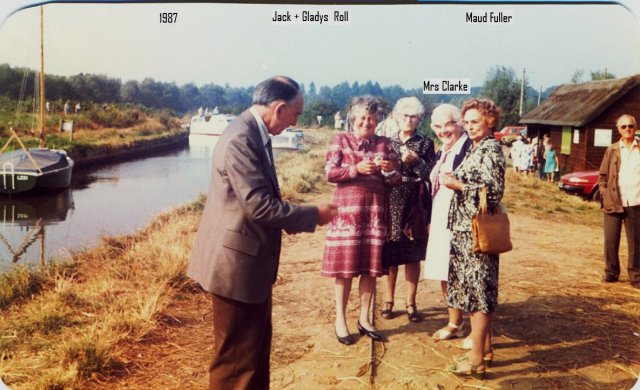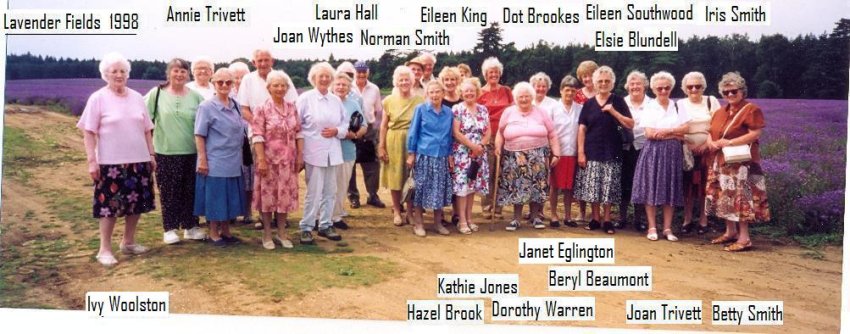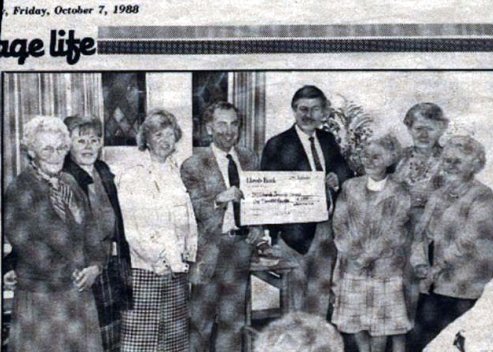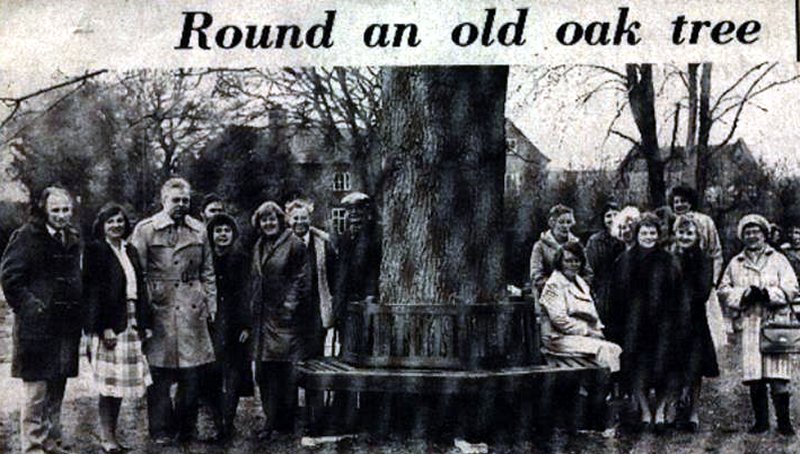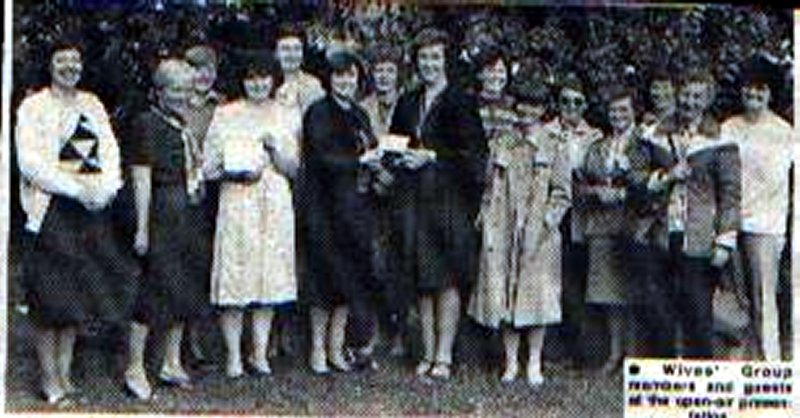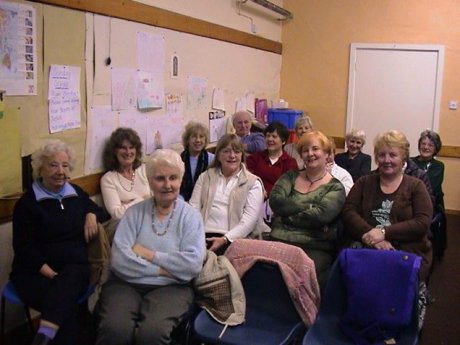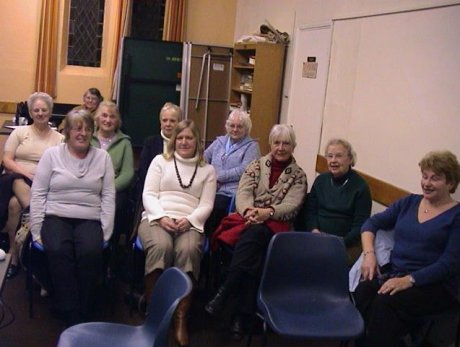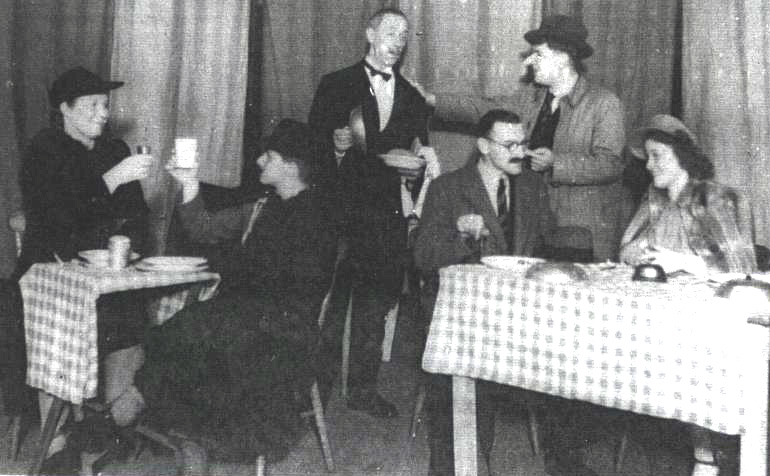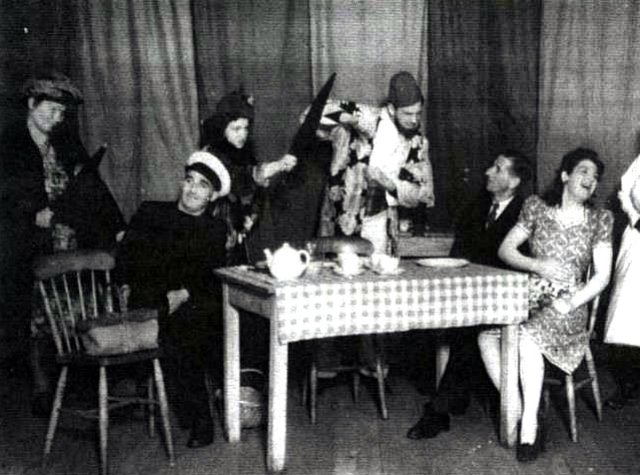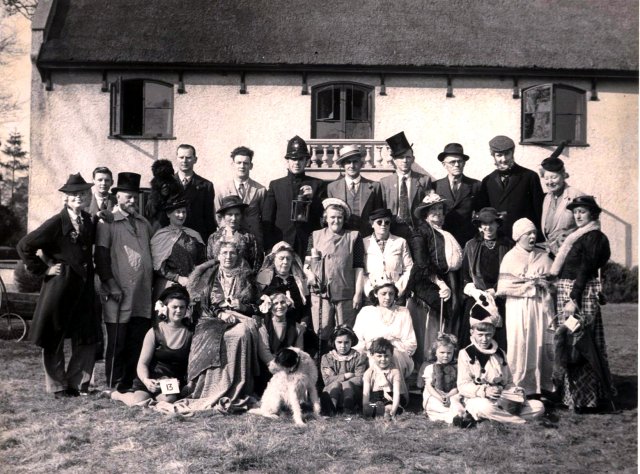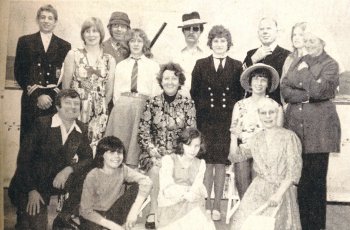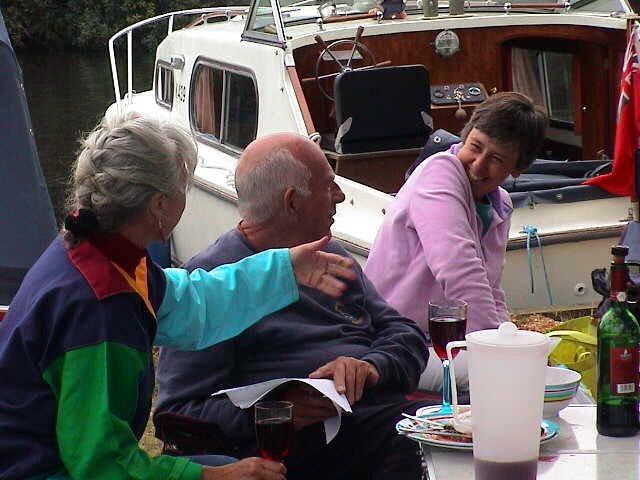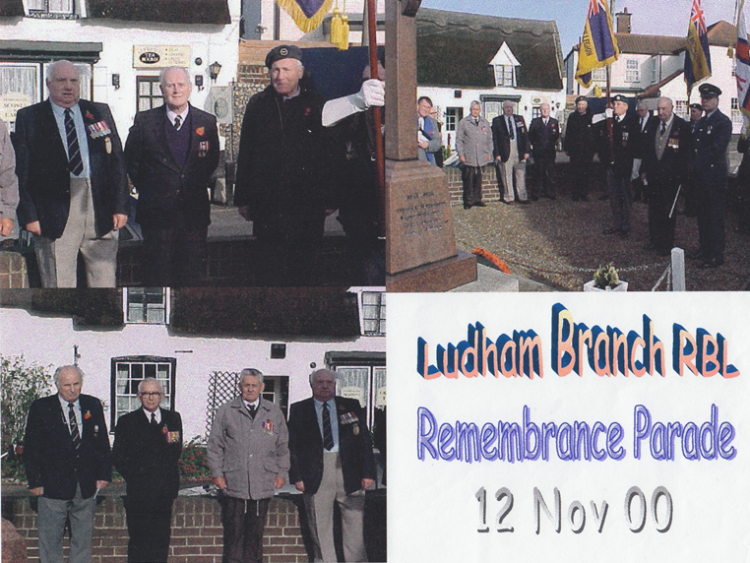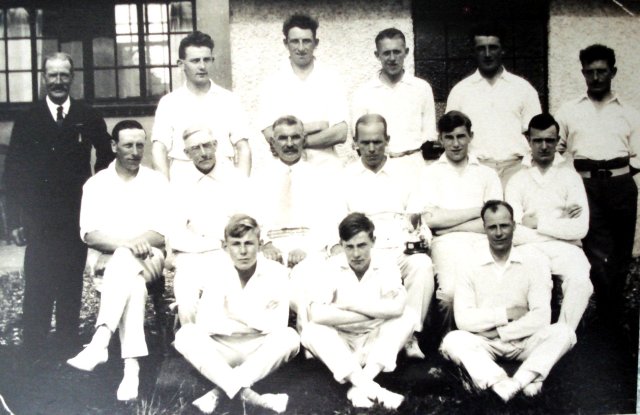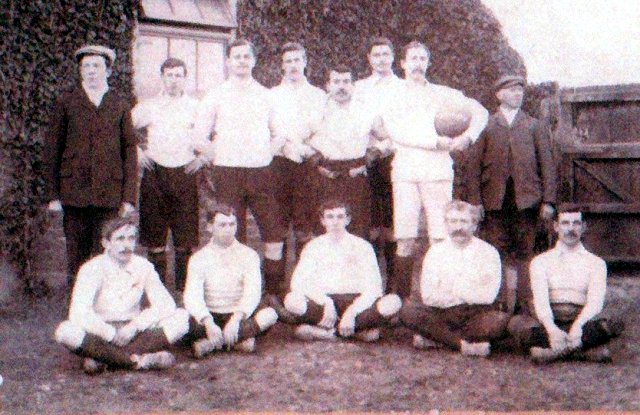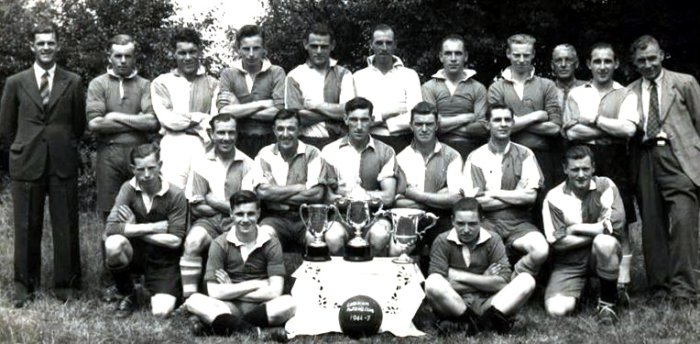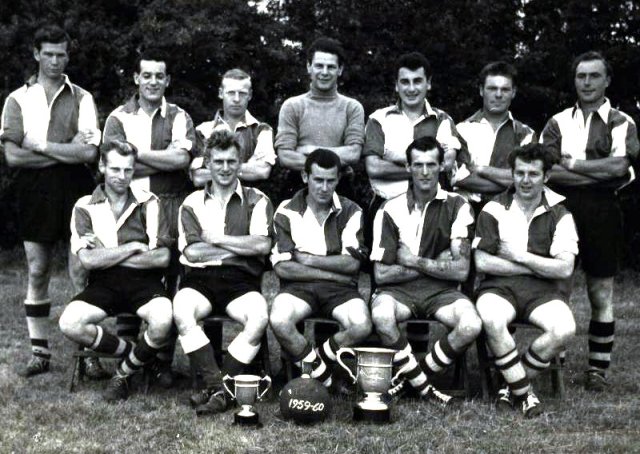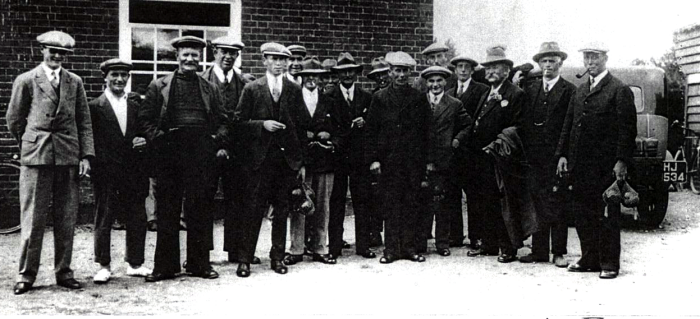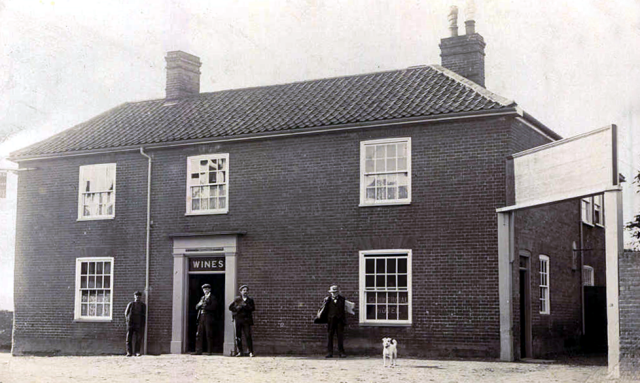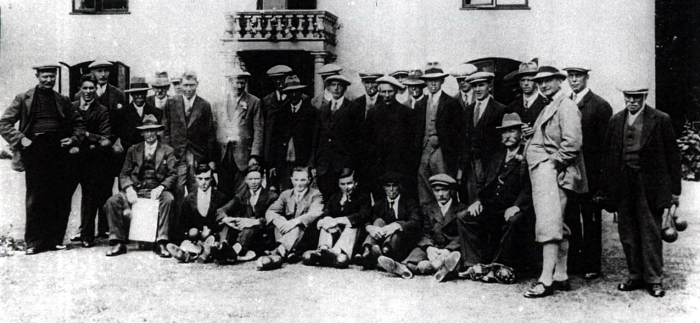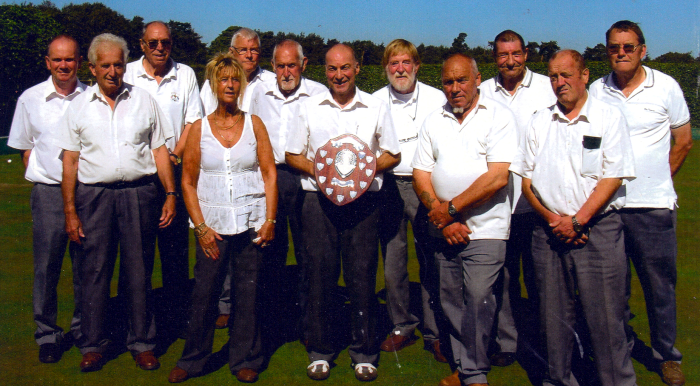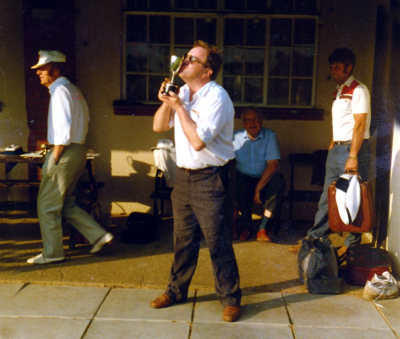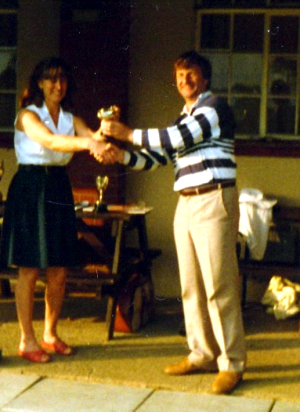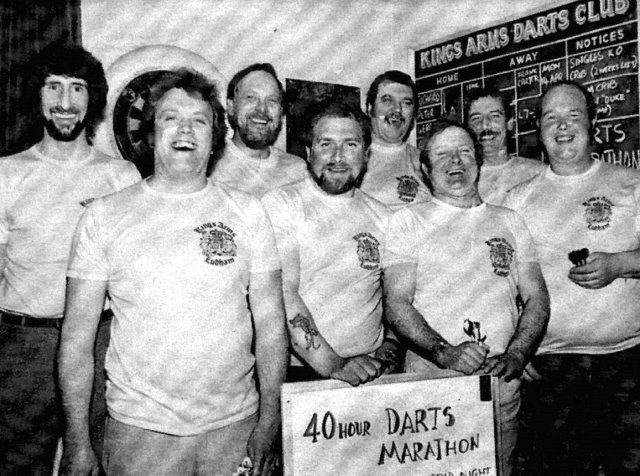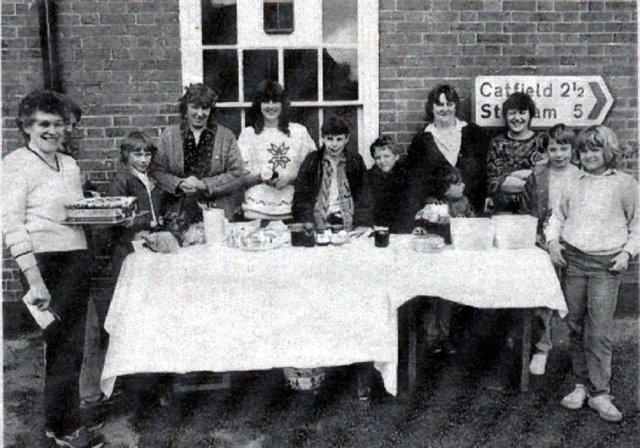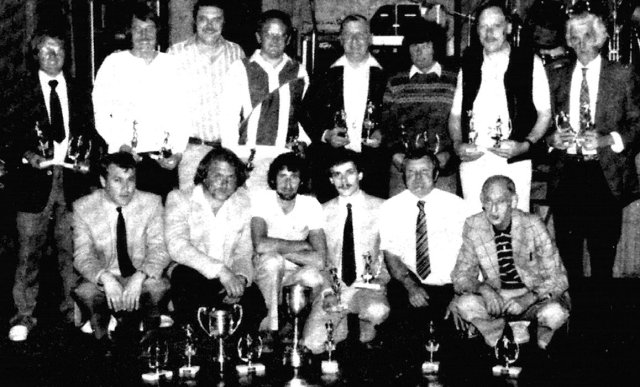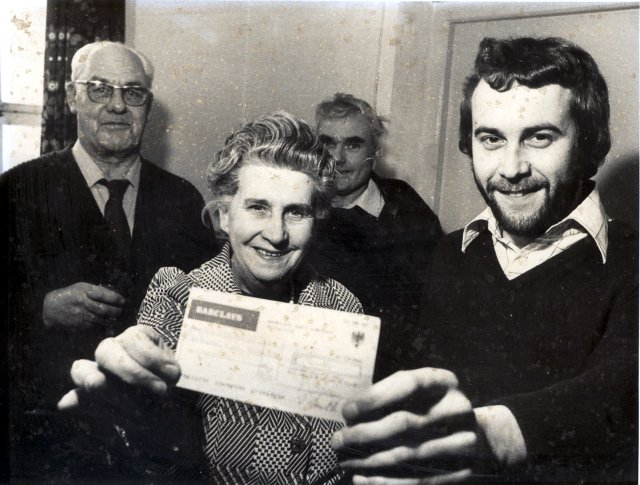|
|
|
|
Chapter
13
Recreational Activities in Ludham
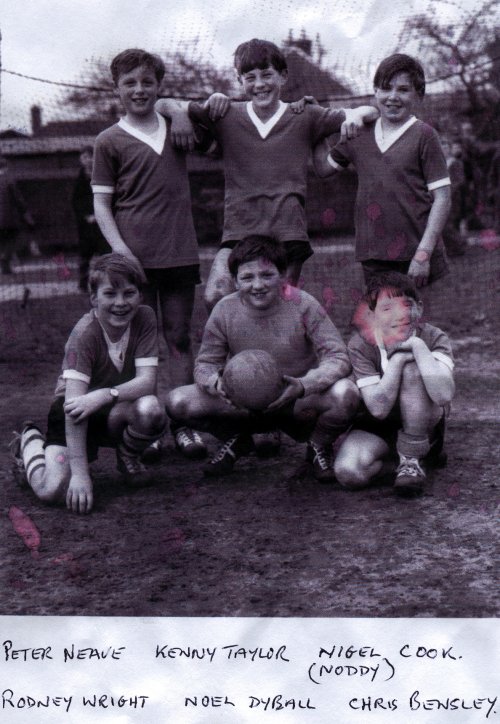
A Ludham Football Team
|
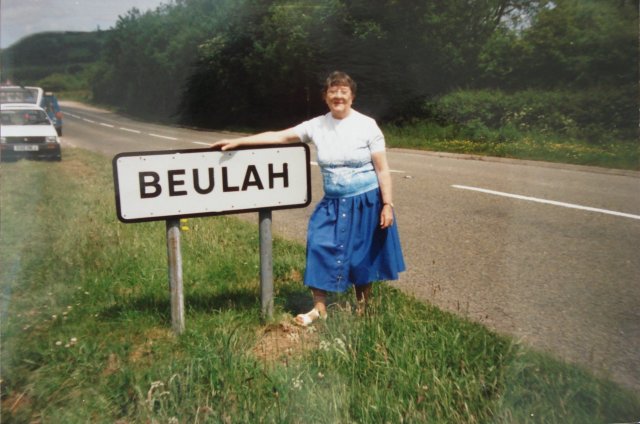
This chapter is introduced by Beulah Gowing. Much of this
was transcribed from recordings made a few years ago, as a
result of general discussion about leisure activities in
the village.
The village hall and recreation ground was built in 1926
for leisure use by public subscription, and is much used
and appreciated. The large hall and raised stage has an
adjoining billiard room, I don’t think the word snooker
was ever used in the early days.
The King’s Arms auction bill mentioned the established
bowling green in the public house sale dated 1831, and was
in much demand. There was also a billiard table at the
King’s Arms. A second green was laid just before the 1939
war but it was not used enough to cover the expenses.
Lockers were provided in an open front pavilion, canes for
measurement and a rotary pump for watering. War took many
enthusiasts from the village and chickens and rabbits
occupied the well kept greens. There were many other
greens in the area, mostly belonging to private houses.
Latchmoor was a square area taken from the field and
belonged to farmer Charles Green of Beech Farm and mostly
fellow tradesmen used that green. I (Beulah Gowing)
delivered beer to their pavilion and to other venues when
I was 14. The bowling green at the village hall was laid
much later, but, they also had a double tennis court plus
football and cricket pitches. Badminton was played within
the hall, and table tennis was played in the Church Room
and the Sloper Room. Ladies bowls teams formed at the
village hall after the war.
There were small oak tables at the King’s Arms, made
locally by Leonard Bush for the older card players, who
argued their way through each game. The Baker’s Arms Inn
also had a billiard table in a purpose built shed in the
back garden. No beer pumps were installed in that public
house, every pint was a journey down the cellar steps. The
Bakers Arms was late in gaining a licence and had been a
farm and lodging house belonging to Garrets.
Darts was popular in the army. Many
were puzzled as to how, in their swift chat, the
local farm labourers could really count much
quicker than the army lads. There was cards,
dominoes and shove halfpenny, a board game of
skill (or luck) which became illegal during the
war. It contravened the Gaming Act and although
dice was discouraged, a furtive huddle up a corner
often meant otherwise. The Dog Inn no doubt had
its own teams of sports men, such as fishing
matches, being very popular with men from the
Yorkshire area.
Sailing and rowing regattas were often seen. Boys
learned to swim in the manor pond before venturing
down to the main river. Ice skating took place
nearly every season, from Ludham to Yarmouth
perhaps.
So, we had bowling, swimming, badminton, tennis,
table tennis, billiards, cricket, football, board
games, cards, dominoes, shove halfpenny, darts,
and more recently, croquet at Folly House. Older
inns had skittle alleys and quoits. There was
always something going on to keep you occupied. |
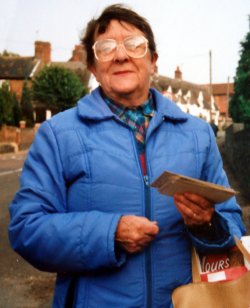
Beulah Gowing
|
The For-Get-Me-Not Club
The Ludham For-Get-Me-Not Club is a club for senior
citizens. It was started by Mrs Waldron, and runs from
February to the middle of December and meets once a
fortnight in the Church Room.

|
When Mrs Waldron retired Mrs Flo
Anderson who worked in the shop at Ludham Bridge
asked if Mrs Paul would see to the running of the
For-Get-Me-Not Club otherwise it would close down.
Mrs Paul who had not long been at Ludham Bridge,
was enthusiastic but knew her time was limited as
she was a very busy lady. She was persuaded that
it would not be an onerous job to do, just to
collect the sixpences each week from the members!
The club was much smaller then and most of the
members were really old. Nurse Attoe was a
competent treasurer and Mrs Paul had very good
helpers, Marjorie Sheldrake, in particular, who
helped with her wonderful cake stalls at all the
sales. Mrs Hill and Mrs Sayer were also very
helpful ladies.
At Christmas a turkey was cooked at home and taken
down to the church room with all the trimmings and
afterwards they had an evening party with games.
Mrs Paul’s husband, Ken, was good at organising
and they had a lot of fun. |
The usual afternoon activity for the club was playing
bingo for small prizes with various other competitions as
well. A lovely tea was provided by all the helpers. In the
summer the club went to Ludham Bridge and had tea in the
garden. One or two venturesome ones went out in a boat.
They had outings to Gorleston where they ate wonderful
fish and chips and went to shows on Yarmouth pier. Mrs
Paul stated “ I found this a big responsibility, I was
nervous of losing someone!” Mrs Paul also said “ I really
enjoyed it and carried on running the club until Mrs
Alexander came along. She had experience of running a big
club before she came to Ludham and I could see she was the
ideal one to hand over to”.
Bingo is still played today for approximately 45 minutes
followed by tea, consisting of sandwiches and cakes
provided very generously by a team of willing helpers who
are also club members.
To help raise money they hold jumble sales in the spring
and autumn, a strawberry tea in the summer and a Christmas
bazaar in late November.
They still go on outings, usually 3 times a year, which
can be to a garden centre, a variety show or a boat trip.
To extend the Christmas festivities they now go out for a
post Christmas lunch during the first week of January.
The Wives Group
The aim of the wives group has always been to support
other worthy charities. The group was started as the
‘Young Wives Group’ by Mrs Searle and Mrs Sloper.
In 1977 there were 34 members with 11 visitors during the
year. In those days membership was 25p with weekly subs of
15p, visitors 20p. The first Jumble sale made £56.93 in
1977 and the Charity for that year received £25. President
Mrs Gregory with the help of her husband Alan and The
Young Wives Group started up the Fun Run in 1982. The sum
recorded is £217.72 made by this event and was donated to
Ludham Village Hall. In1983 it raised £411.69 with a
donation of £200 to the Parish Seat, in 1984 it raised
£516.90 with £311 going to the Play Area and in 1985 it
raised £607.74 , given to Norfolk Accident rescue.
As this yearly event was getting too big for Wives to
handle it eventually passed to the Ludham Parish Council.
Also, as the membership of the group got older it was
decided to rename it ‘Wives Group’ as it still is today.
All age groups are however very welcome.
The Wives always meet fortnightly on a Thursday in the
Sloper Room at 8pm when they have speakers from many walks
of life. They also have outings to a variety of local
places. They work to raise money for charity through
jumble sales, bring and buy, raffles and a annual wayside
stall on Baker’s Green.
They financed the making of the Mardle Seat and its
continued upkeep and into the twenty first century saw
them volunteer to help at the New Year Fireworks Display
for the village.
An Extract From The Parish Newsletter - 1984
Some of the charities ’The Wives’ have supported are:
Air Ambulance
£444.00
Hearing Dogs
£200.00 Louise
Hamilton £100.00
Chapel Toilet
61.66 Caister
Lifeboat
£300.00 Isunami
Dis
£100.00
St. Matthews
£300.00
Charter Fair
£300.00 Breast
Cancer £300.00
Crossroads
£200.00
Quideham
£250.00
Macmillan
£250.00
Help For Heroes
£600.00
Sailing for Disabled
£600.00 Mrs
Khambata £25.00
Nelson Journey
£600.00
Homeless
£600.00
School
£500.00
Methodist Chapel
£300.00
In 1988 a cheque for £1000 was presented by Graham Smith,
an organiser of the Ludham Fun Run, to Dr Bob Jarvis, of
Ludham Surgery. The money raised was to be used for an
electrically-operated couch for the surgery. Thanks were
extended to the Ludham Wives Group and all the helpers,
competitors and sponsors.
Left to right:
Elspeth McCambley, Rita Lumley, Janet
Smith, Dr Bob Jarvis,
Graham Smith, Betty Holand, Doreen Lloyd, Dorothy Xxxx
The seat at the top of Horsefen Road, was made by Mike
Fuller and has the inscription "Sit you down and mardle".
The money was raised by a mini marathon fun run organised
by Sheila Gregory and the Ludham Wives Group. The seat was
presented to Ludham Parish Council on 25th March, 1984.
In 1987, £200 was raised for the Big C Appeal. Members of
the Ludham Wives Group and visitors met at the home of Mrs
R. Brown where everyone sat in the garden and enjoyed an
American supper.
Among the guests were Mrs Marlene Stevens and Mrs Ann
Barley, representatives from the Big C appeal. A cheque
for £200 was presented to Mrs Stevens by Mrs Sheila
Gregory who said this was the money raised from the Ludham
Fun Run. Mrs Stevens expressed her thanks to everyone who
had taken part in raising the money for the Big C Appeal.
A bring and buy stall made £5.
The president, Mrs C. Mobbs, thanked Mrs Brown for the use
of her garden for a most enjoyable evening.
Wives Donation To The Laura Jayne Smith Trust In 1989:
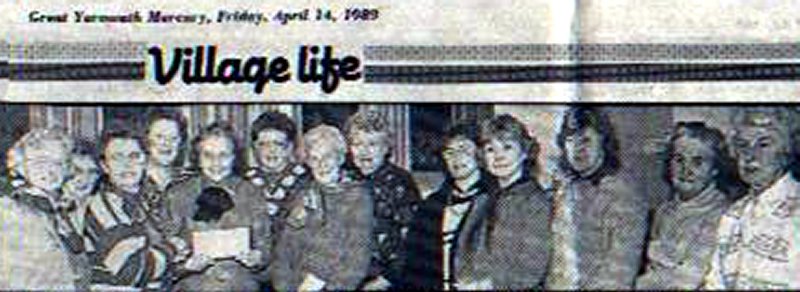
The Ludham Wives Group meeting opened with the
presentation of a cheque for £200 to Mrs Jane Edmonds on
behalf of the Laura Jayne Smith Trust which members agreed
was a worthy charity.
Laura Jayne, whose home is in Potter Heigham, is blind,
has brain damage and suffers from cerebral palsy. Mrs
Edmonds, a leading figure in the appeal for money to help
the little girl's parents look after her, thanked Wives
Group members for their kindness towards Laura Jayne. This
was the group's first meeting after the Easter recess and
the vice-president, Mrs Elspeth McCambley, was in the
chair. The cheque presentation was followed by a talk and
demonstration on the history of puppets. Ted and Stephanie
Rowe, of Zodiac Puppets, showed how intricate the little
figures are. Their talk fascinated members at this well
attended meeting, and Mrs Janet Smith proposed a vote of
thanks on behalf of an appreciative audience.
The Presentation Of Yet Another
Cheque for Charitable Purposes - The Date Is Unknown
<Picture> wives 7 and 8
A Typical Meeting In The Latter Stages
Of The 20th Century
|
The Ludham Mini Marathon
Fun Run
Mrs Shiela Gregory with her husband, and helped by
the Ludham Wives Group, was the instigator of the
Ludham Mini Marathon Fun Run in 1982.
Over the years much money for charity was raised
through this enjoyable, fun event. The villagers
and nearby neighbours were only too willing to
take part. Fun was to be had by all. The first
lady home was Caroline Mobbs. |
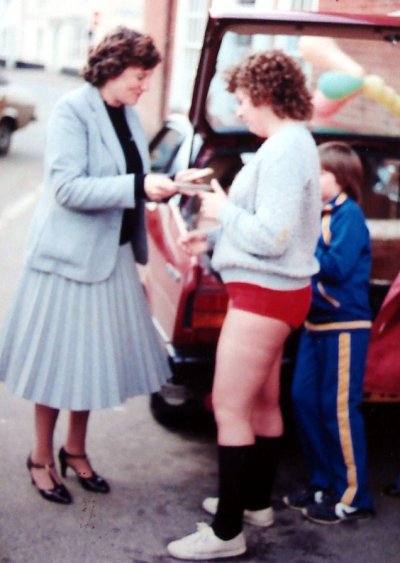
|
In 1985 about one hundred contestants turned up for the
annual Ludham Mini Marathon Fun Run. The event was
organised as usual by Sheila Gregory and the Wives group.
The Wives stated that nearly £800 had been raised for the
surgery.
“It was the best we’ve ever raised”. The money was to buy
one or two radio sets to be used in conjunction with the
Norfolk Accident Rescue Service. The winner of the fun run
was Mr Tony Barber from Sutton and the first lady home was
Mrs Penny Brown. Neil Metcalfe was third picking up the
trophy for the under 11’s section. Anthony Lavender and
Hayley Forton were winners in the 11 – 16 section. Mr Mike
Spanky won the fancy dress with his caveman’s outfit.
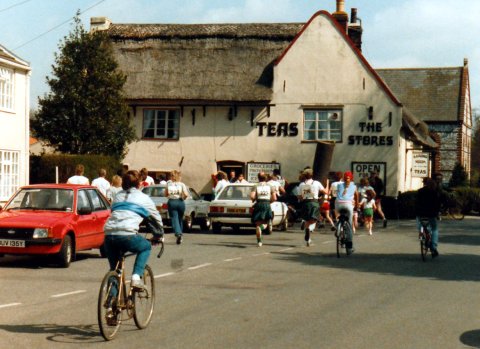
|
The fun run in 1986 made £793
for the Eastern Daily Press ‘Cherish That Child’
appeal This fund with help from all over the
county was close to the establishment and running
of a Child Protection Team.
|
£850 was raised in 1987 in aid of the Toy Library for
handicapped children in Norwich. The trophies that day
were presented by Mrs Joyce Newham from the centre.
Amongst the trophies won, Simon Crawshaw and Peter Durley
walked away with the fancy dress trophy as Zulu warriors
complete with canoe and spears.
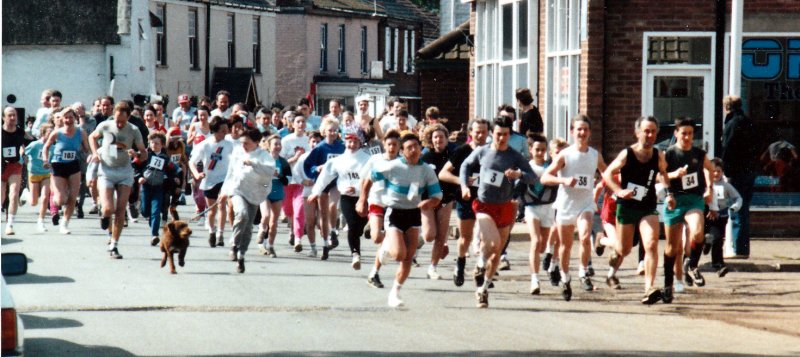
An enormous £1000 was raised in
1988 and went to the benefit of Ludham surgery.
This time the money was spent on an electrically
operated couch which would be a great asset to the
village health care.
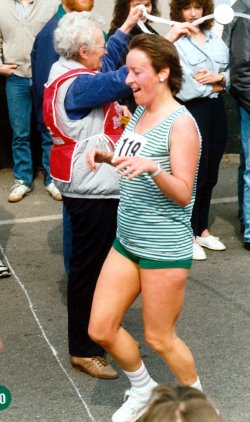
|
Yet again there was a
good turnout in 1989 with the sun shining
brightly on all who took part or came to
watch. Many participants wore fancy dress
and the magnificent sum of £3,700 was
raised for the charity ‘Break’. This was a
charity giving parents of children with
long term congenital conditions, the
opportunity of a break. A new cup was
introduced by Guy and Tommy Thrower for
the first Ludham resident to complete the
course. It was won by Anthony Moffat in
28.02 minutes. The fancy dress winners
were Barrie Marshall as grandma, Laura and
Catherine Cordiner and Nicola Blake as
cheer leaders and Katie Mobbs as a fairy. |
|
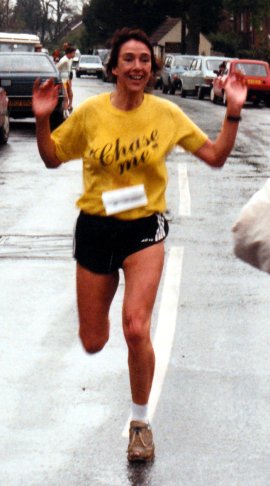
|
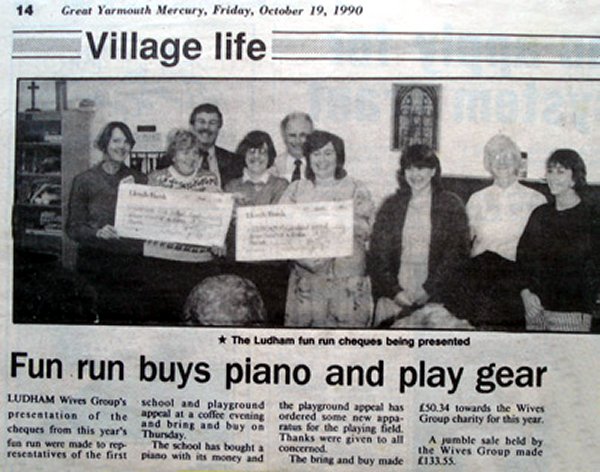
|
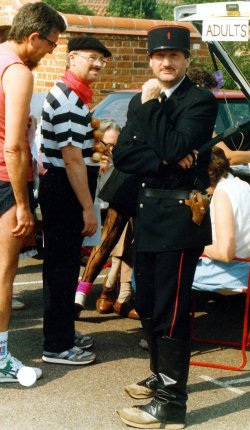
|
The Fun Run bought a piano and play gear in 1990 with 113
people taking part. It raised £1458 to be shared between
the Ludham First School and the Children’s Playground
Appeal. Yet another trophy was introduced by the directors
of Moores of Stalham – The Airfield Trophy. This was for
the first person, home resident or employed, in the three
airfield parishes namely Catfield, Ludham and Potter
Heigham.
| Despite the coldest weather yet
with winds and rain hampering contestants 130
people took part in the 10th annual fun run event.
Sheila Gregory who had been the instigator of this
event was invited to return to present the
trophies. Childline was the chosen main charity
but also money was used for a commemorative tree
and seat for the village. |
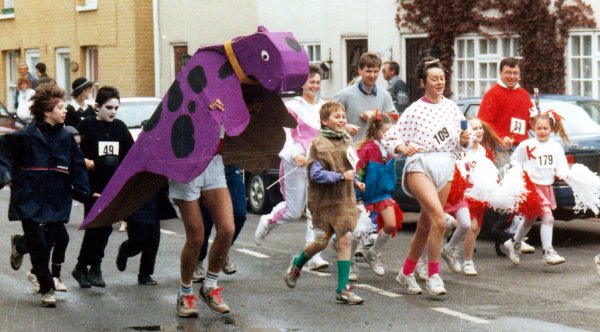
|
The Ludham Fun Run Charities:
1982
Ludham Village Hall
1983
Circular seat for Womack Corner and
Grapevine Talking Newspaper for the Blind.
1984
Equipment for the Children’s
Playground, and Norfolk & Norwich Big ‘C’ appeal.
1985
Norfolk Accident Rescue Service.
1986
EDP ‘Cherish that Child’ appeal.
1987
Norwich Toy Library for handicapped
children.
1988
Ludham Surgery. Multi purpose
electrically controlled couch.
1989
‘Break’ Sherringham.
1990
Ludham First School and the Children’s
Playground appeal.
1991
Commemorative seat and tree for the
village and Childline.
This community spirited village event carried on into the
21st century but unfortunately eventually ceased. Perhaps
someone in the future will come forward and be the leading
light to get it going agai
The Judo Club and Wolfgang Bubenzer
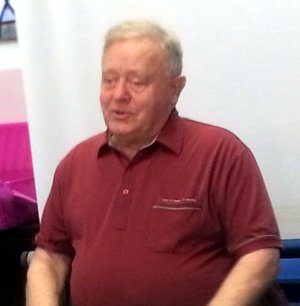
|
Having run a Judo club for 25 years
in London, not long after we came to Ludham
someone suggested “ why not start one here”. Yes
why not? I missed it actually. There were a lot of
children running around with nothing to do so it
would be an ideal thing for them.
First of all I went to the Parish Council and I
have to say, Billy Sloper was an angel, he was on
our side right from the word go. There were a few
doubting Henrys there, but Billy Sloper and Arthur
Gower, they were the two who really supported my
idea of running a Judo Club in Ludham.
It was going to be in the village hall so the
council said that provided we raised the money for
the equipment, they would purchase it all and save
us paying the VAT. My girlfriend and I went round
knocking on every door in Ludham, explaining that
we were going to start a Judo Club for the
youngsters, and we needed £250 for the equipment
to get it going, the mats, the canvas, the woods
and all the rest of it. When we had got the money
together I held the first meeting. By this time
word had got round and lots of parents came down
with their children, and I said, “If you want to
enrol your boy or girl it will cost you 30p a
week. From 6 o’clock to 7.30”. We got at least 30
signed up on the night and I went back to the
council with the money and they bought the
equipment. |
We started to set up the club,
making arrangements to get the judo suits for the
children from Manchester. If wasn’t long before we
had a thriving club called Ludham Broadland Judo
Quai. My son did a badge motive and we had one
stitched, which could then be sewn onto the front
of the jacket, and also Ludham Judo Quai had been
printed on the back of their jackets. I managed to
persuade my boss at work to donate 50 track suits,
all with the club name on the back and the badge
on the front, at no charge to the club. So all the
children and grownups all looked the same, all had
the same suit and all wore the same clothes, all
little red devils they were. It was great and we
had a really good club.
We started taking the children away, and, other
judo clubs used to come down and join us, staying
with the parents of children who did Judo in
Ludham. We had the same invitation out to places
like Lancashire and Wales, where our children
stayed with their parents, did Judo on the
Saturday and Sunday morning, then went down to the
beach, or we climbed a mountain in Wales and came
home again for Sunday night.
|
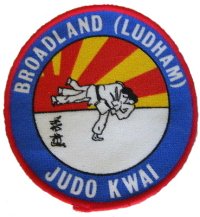
|
This went on for quite a long time and then they decided
to have a committee, and ultimately, that killed off the
club. Judo is very autocratic. Whoever is in charge, is
absolutely in charge, and in London, for 21 years I was in
absolute charge of the club, and no-one, unless he was a
higher Dan grade would argue with you. If he was a higher
Dan grade, you said yes sir, three bags full sir. That’s a
typical Japanese attitude. I had had several National
Champions in London, and I had 3 youngsters here from
Sutton who looked likely to become National Champions as
well in their own grade. But the powers that be (the
committee members) thought they knew better, so I said
“Fine, it’s all yours”, and I walked out and the club
folded about 9 months later.
I must name a few more that helped out. Nicky Brooks, Alan
King, Rodney Wright, Nicki Haslem and her brother Cliff,
Sarah Firmin and Sarah Perton and quite a few more.
Some came from outside Ludham, but we had about 15 grown
ups and about 40 juniors in the club.
|
The Ludham
Womens Institute
Founded In November 1935
Because of the sheer quantity of research material
available for this section, we will once more
adopt the technique of doing no more than dipping
our toes in the water.
This section will offer the reader a flavour of
what was going on within each of the decades
covered by this book. |
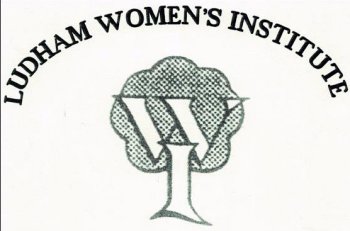
|
First Committee
President:
Mrs Cambie (Grandmother of Bishop of
Norwich, Maurice Wood)
Vice
Presidents: Mesdames Goldsmith Brown and
Mohan.
Committee:
Mesdames Grimes, Hacon, Riches, Rix,
Anderson, Keeler,
England and 'Aunty'
Bush.
Decided to collect stamps and silver paper for the
hospitals.
July 1940
Committee Meeting note - Tea ration discussed and two
members, Mesdames Carter and
Sayer promised to bring some to make enough
to last the year.
No More Monthly Records Were Kept Until 1944
1944
Mrs Ankerstein gave talk about her life in occupied
Poland, of the oppression and
her escape to England.
A War Savings Group was started by Miss Goodey.
Plans for 'Salute the Soldier' Week.
Volunteers were asked to knit garments for liberated
countries.
It was decided to start a Market Stall. It was a great
success, selling surplus fruit, vegetables
and flowers from members gardens. Made turnover of
£112/12s/6d.
1946
A parcel of produce sent from Australia was shared by a
raffle.
WI gave £1/1s/0d to local War Memorial Fund.
1947
Bad weather caused cancellation of meetings in February
and March.
1949
63 members. Entered Norwich Exhibition - won a number of
awards.
Canon Wake, Vicar of Catfield, was a favourite speaker at
the Institute.
1950
Postage stamps collected for Children’s Hospital at
Hackney.
Lady Delia Peel (Lady in Waiting) spoke of the Royal Tour
of South Africa.
50 members at the Christmas Party.
1959
Speaker Miss Hoare. An amusing talk about WI
particularly about welcomes at the door - the most
important place of welcome.
Resolutions for CAGM - 1) to form a WI Group
system 2)a University College for Norwich.
Demonstration by Cadbury's. There were 57 entries
for Exhibition. Miss Moll again won cup.
Talk on 'Life in Japan' by Mrs Howard.
In June two members offered to help at a mass
x-ray in the village hall.
Demonstration of Sweet Making. Soft Toy
Demonstration - Arrangements made for classes.
Garden Meeting at home of Mrs Snelling, Hall
Common. There was glorious sunshine for 3
hours. Competition, hunt for
butterflies. Mrs Snelling’s children most
interested, they had hidden them!
Outing to Ipswich, Sudbury Silk Mills and Lavenham
for tea.
A talk was given by the Chief Officer of Norwich
Prison. Worked in prisons for 29 years. There were
56 prisons and 28,000 prisoners. What about our
prisons today - 1985!!! |
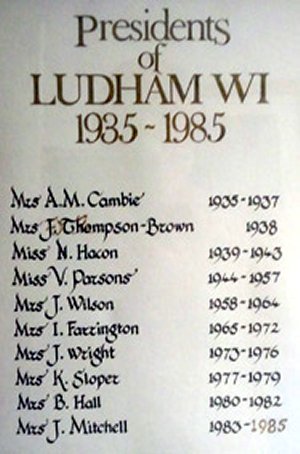
|
Talk arranged by Mrs Bartlett, WVS on Nuclear Warfare An
appeal to attend.
Whist Drive for Institute funds made £3/12s/6d. £1/18s/8d
sent to Guide Dogs for blind from sale of milk bottle
tops.
Three nominations for President - Mrs P Wilson re-elected.
St Dunstan's Whist Drive made £16/12s/0d. NB supported
better than Institute Whist Drives.
December, Competition 1/- parcel. Entries given to Forget
me not Club.
Miss Burney gave a talk on ‘Strange Meals in Strange
Places'.
Christmas Party for 48 members and 18 guests. The games
and supper were organised by the committee.
1969
Annual Dinner held at Sutton Staithe.
Mrs Christie was awarded the WI Goblet for 1st, 2nd and
3rd in competitions.
Support asked to oppose closure by NCC of right of way to
How Hill Staithe.
Flower classes to be held for six weeks. Demonstrator Mrs
George.
Keep fit classes held in Primary
School.
New village sign, designed by Mrs Snelling
(member) and carved by Mr Freeman-Sayer,
both Ludham residents.
Arrangements made for rush work classes.
1979
Talk by Mrs Farrington and Mrs Sloper, with slides
taken by Mrs Sloper, on their visit to Norway.
Suggested that a group of trees be planted in
Churchyard to obscure foundry buildings.
Talk given on pewter work.
Lack of support for Cambridge outing so members
joined Thurne and Repps in outing to Kings Lynn. |
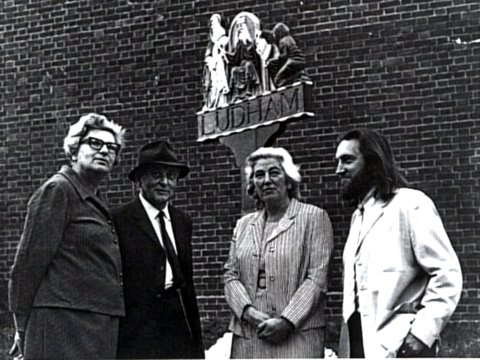
|
Souvenir holiday stall suggested. Mrs Evans gave a pastry
cook's tour of Europe.
Jumble Sale made £26 and Red Cross collection £87/7s/0d.
Institute exhibition, Mrs Adams & Mrs Elphick
Exhibition secretaries. High standard. Mrs Elphick won the
Cup.
Mrs Mason won prize in Year of the Child short story
competition. Prize presented at the Assembly House
Norwich.
July meeting. Ploughman's lunch held at the home of Mrs
Anna Wilson.
Tree planting in Churchyard. Mrs Knight held coffee
morning and Mrs Sloper a tea party to raise the necessary
money for the scheme.
Subscription next year would be £2.25p.
Cake and produce stall on Bakers Arms Green £26.72p for
NSPCC.
In September the speaker Mrs Hissen, gave a most vivid
account of her work with the French Resistance. She was
awarded the Croix de Guerre.
34 members
Mrs Hall elected new President in November.
1989
42 members attended the January meeting, no
apologies!. Among plans for the future was the
suggestion that First Aid classes should be held.
The Norfolk Association for the Disabled
would be this year's charity. A
letter would be sent to NNDC Highways Department
in support of the Parish Council's request for a
speed limit through the village.
In March members were asked for goods for the
annual Jumble Sale. Once again members volunteered
to keep Stocks Hill tidy for the Best Kept Village
competition.
First Aid classes were held in June. Mrs Crocker
was thanked for excellent outing
arrangements - where did they
go? Miss Pettit would go to a
meeting to discuss the future of Evelyn Suffield
House. The Institute meeting was again an open
evening meeting with supper. |
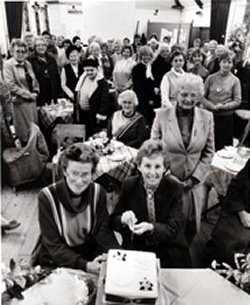
|
The July Garden Meeting was hosted by Mrs D Lloyd, 45
members and guests were present, it was again a lovely
afternoon for those present to enjoy the garden, the tea
and each other's company.
In September members were told that the subscription for
1990 would be £7.50 and held at that for two years. A new
WI constitution had been introduced. Each Institute was
asked for an annual contribution of £10 toGroup funds.
Members agreed to this.
On 5th October, at a special Meeting members voted for the
sale of Suffield House. An outing to Bawdeswell Garden
Centre was proposed. The Coach to the Christmas Fayre in
Norwich would once again be free to members. Our team had
represented us well at the Horning Quiz.
At the County Autumn Council Meeting 218 delegates had
voted for the sale of Evelyn Suffied House with 53 against
the sale.
At the Institute October Meeting it was proposed that we
should hold an August Meeting, as there was too much
business at the September Meeting. The August Meeting to
be solely for Institute business and a social gathering.
The proposal was accepted.
Annual Meeting, 10 members volunteered for committee. Mrs
Crocker was elected as President.
At the December Meeting Mrs B Gowing was the first winner
of the Miss Parsons tray awarded for
the highest number of competition points gained in the
year.
Christmas tea was accompanied by a general knowledge quiz
and Christmas Carols.
1999
Five new members were welcomed at the January meeting.
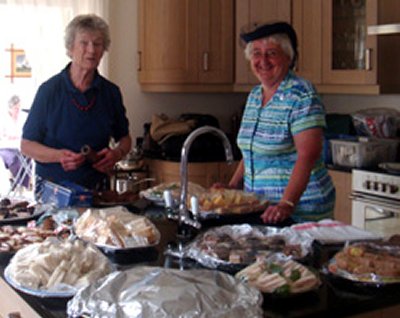
|
In February Joyce Ferdinand had
used squares knitted by members to make a pram
blanket to be sent to Romania, members were keen
to take this project further.
In May we held a very successful fashion show in
the Church Room raising £90.
This year the garden meeting was blessed with good
weather and was enjoyed in Jan Bailey's garden.
In September an outing to Blickling Hall was a
great success and we hosted a successful Group
Meeting in the village hall.
Our October coffee morning raised £60 and this was
donated to Ludham Play Group. |
In November Jan Bailey was re-elected President and we
finished the year with a very good lunch at The Bridge,
Filby and a delightful entertainment of 'music and mirth'
by Eric and Rosina Jones at our December Meeting.
Drama Groups In The
Village
Drama has played its part in Ludham since way back in
pre-war days with entertainments, concerts, live music,
comedy and drama but perhaps for this chapter, we will go
back to 1945.
Here we see enthusiastic members of the community putting
on a concert party which would include short sketches and
lots of singing.
Possibly being staged in the late 1940’s or 1950’s, we see
Marjorie Bird, Freddy Pegg, Bob Burton, John Rix, Sam Hall
and Jeanne Woods.
The Manor Concert Party, 1948
|
Gill Jackson comments on
setting up
The St Benet’s Players:
When I was at Salhouse the W.I. had a drama group,
so, when I moved to Ludham I found that there had
been the Ludham Players with Pop Snelling and some
others.
Pop was really helpful, she gave us some old
photographs and information showing how the stage
had been set up. Maybe we could get the Village
Hall back in use as a theatre. Well, for a few
nights every year, anyway. |
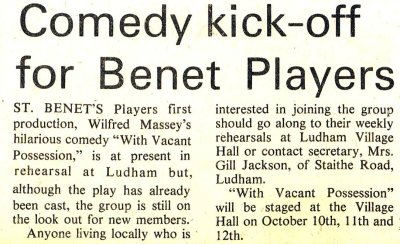
|
I had been to a talk given by Herbert Mitchell, the County
Drama Organiser. I was interested in his talk and later, I
phoned him up and said I’d got some friends, and that we’d
like to start a group, could he advise us? He said, ‘Form
yourselves and then get me to come out’, so we started.
The St. Benet’s Players, named after the nearby St.
Benet’s Abbey were first formed in June 1974. The
inaugural meeting was held in Ludham School and was
attended by 14 people and that was just by putting posters
in the village. As a result of that, a committee was
elected consisting of John Wythes (Chairman), Gill Jackson
(Secretary), Stan Gibbs (Treasurer) and John Affleck
(Business Manager).
Herbert Mitchell came along and talked to us about
licences and performing rights, because if you don’t have
the licence to perform you could be closed down, then
everybody gets disappointed and probably fined as well, so
it’s not worth trying to avoid it. We do try, both then
and now, to write our own material which allows us to be a
bit freer with costs and things like that.
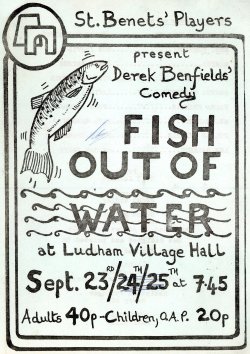
|
The Artistic Director for the first
production was Muriel Affleck. Mr and Mrs
Underwood kindly lent their Barn at Albury House
for a coffee evening to help raise funds for the
group, and the ‘Players’ also had a wayside stall
and a jumble sale during that summer to help with
the funds needed for the first production, a
comedy called ‘With Vacant Possession’ written by
Wilfred Massey. It was a sell out on the first
night with standing room only for late comers.
The comedy was about two families renting the same
house. The press claimed that the outstanding
performances in the cast of ten (some of whom had
never acted before) were Lynn Freeman and Joan
Wyths who stepped in at the last minute. The
producer, Muriel Affleck, was also congratulated
by the press ‘for getting so much out of the cast
who had so much raw talent that had to be shaped
into its first real performance’.
Membership of the group spiralled in the months
following the inauguration, with membership coming
not only from Ludham, but also Horning, Stalham,
Sea Palling and elsewhere. They also had hopes of
perhaps putting on a serious drama such as an
Agatha Christie.
|
They then ventured into the realms of a musical with
‘Let’s all Go on the Broads’, again written by Mu Affleck.
As well as the players it included ‘The Dancing for
Pleasure’ group and members of the ‘Stalham Choral
Society’ directed by CHE Moggs.
Other
Notable Productions:
October 1974
With Vacant Possession
January 1975
The Other Cinderella
October 1975
Murder At The Vicarage
September 1976
Fish Out Of Water
June 1977
Blithe
Spirit
December 1977
Wild Goose Chase
March 1978
Mystery At Blackwater
July 1978
Reluctant
Debutants
January 1979
Last Voyage of the SS Randoon
May 1979
Cat on the
Fiddle
December 1979
Snow White
March 1980
Thriller of the Year
July 1980
No Time for
Fig Leaves
December 1980
Sleeping Beauty |
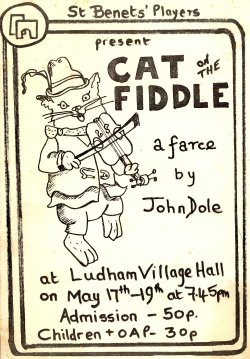
|
The cast of
‘Last Voyage of the SS Randoon’
Clubs, Associations and Activities For
Young People
Yvonne Boldy recalled what the youngsters used to do to
entertain themselves.
In times gone by school outings were very rare, only
London once on a coach, not to the seaside or anything.
We went out more with the Sunday School. I loved the
Sunday school. The Church room was packed with children
and there were about four or five teachers. My teacher
was Peggy Lumbard who lived near Ludham Bridge, she was
very good. There were no after school activities, we
used to go and play at Womack in and out of the brick
kilns, and we used to go for walks, it was so safe for
us to walk round Ludham. We used to do a lot of bird
nesting, which seems awful now, but everyone did it then
and I used to play in the brass band too.
We never went on the river, but I did a lot of
fishing with my dad at Little Holland and at Hunters
boatyard. We never ate them, but we did have relations
living on the coast at Eccles and Sea Palling, and my
dad used to do a lot of sea fishing with my brother,
cousins and uncles.
We didn’t have Guides or Brownies, but we did have
the Girls Friendly Society (or on bad nights it was the
Girls Fighting Society!) run by Mrs Anderson.
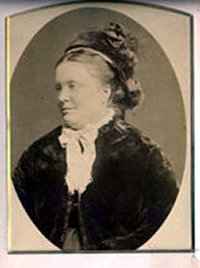
|
The Girls Friendly Society’ was
officially established in England on 1st January
1875 by Mary Elizabeth Townsend, an Irish
clergyman’s daughter married to the wealthy
Frederick Townsend. She once wrote “If the power
of rescue work will be so increased by
organisation, why should no work be organised to
save from falling?” In modern terminology, from
its inception GFS was concerned with prevention.” |
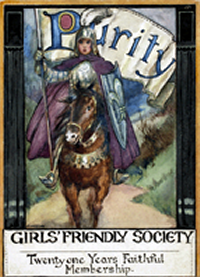
|
Yvonne Boldy continues: “One year my name was pulled
out of a hat and I was sent on a holiday to the Isle of
Wight for a week and I went with Margaret Woods. She was
homesick and they wanted me to go home with her, but I
wouldn’t be persuaded so I stayed and she had to have
someone sent home with her. It was a lot of fun. Mrs
Anderson took us on the train and across London to hand
us over at Southampton to a lady who took us on the
ferry to the Isle of Wight.
Mrs Anderson got cross with me for putting my head
out of the train window and because it was a steam train
I got smuts all over my face. I remember her damping her
handkerchief with spit to wipe it over my face. You
could never do that today, and of course the smuts
didn’t come off. It was the first time I had been on a
train. It was wonderful, I was very lucky to win it.
Other girls went on other years. She was a wonderful
lady, Mrs Anderson.
The Girls Friendly Society (GFS) did things like
knitting and sewing and drawing which I loved. We played
games too, a bit like the Guides and Brownies are today,
but no camping. It was held in the Church Rooms on a
Monday evening for about an hour and a half. I have two
certificates in my possession in the original frames,
but you can barely read them now.
There was no Boys Friendly Society, the boys used
to just play football. We did a lot of plays at the
school and the lady at the Manor, Mrs Brookes, who was
at one time Mrs Armytage had us there and we had plays
and dressing up, very family orientated and everybody
took part in it.
Helen Watson has said that when she was about 8 years old
there were no guides in the village so she joined The
Girls Friendly Society which had been established in 1875.
It was a registered charity working to support girls and
young women in England and Wales then later she joined the
Young Peoples Union which was a religious Youth Club for
boys and girls.
In the late 40’s there was a
Youth Club started up in the Sloper Room on
Tuesday evenings and in the village hall on Friday
evenings. A young lady called Carol Willoughby was
one of the table tennis players! There used to be
country music, table tennis and snooker available
and a record player which was somewhat noisy
according to Billy Wight. It was where he did all
his courting!
Kathleen Sloper commented that:
“One thing was wonderful - the vicar used to
come in every Friday night. He was always
interested in what the youngsters were doing and
also, in their education. That was the Reverend
Fred Smith. He used to come in with his big
black Homburg hat and one of the boys used to
get hold of it and they used to be inclined to
hide it from him. He was so interested in the
youngsters and I did admire him for coming in
every Friday evening” |
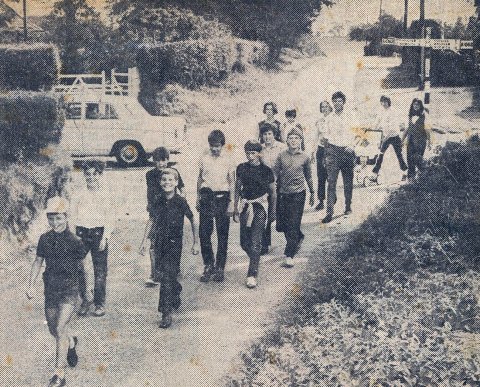

|
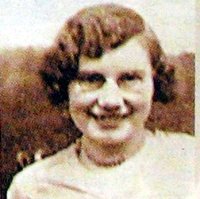
|
Carol Willoughby has stated that “At a later
date, after we had the Youth Club, we also used
to go down to the Vicarage on a Sunday evening
and used his study as a meeting place, it use to
keep us off the road and things”
Joyce Birch said: “We had Brownies in Ludham –
in the Church Room. Mrs Pegg ran the Guides and
Brownies and I remember the uniform I used to
wear – brown uniform with a straw hat in the
summer. I never joined the Guides because I had
to go to Fleggburgh – that was a wasted time for
us” |
Girl Guiding U.K. - Winnie Baker
“Guiding in Ludham was started by Mary Hayes
who lived in ‘Dormers’ on Norwich Road in
Ludham. Di Stagg and I told Mary that we had
both been Guides, and she said “Why don’t you
come along and help?
So we went along on Monday, the
meeting night, and from 27th October 1971 we
became assistant Guiders. Ludham guide Deborah
Taylor won the movements highest award, the
Queen’s Guide Certificate and the village hall
was packed to capacity for the presentation.
Guide leader Mrs Mary Hayes paid tribute to
Deborah’s hard work, the way she had
wholeheartedly supported functions in which the
company had taken part and her service to
others. Deborah then cut a special cake in the
shape of the Trefoil Badge and decorated by
assistant guider Winnie Baker.
Di eventually moved and Mary retired, so I
took over running the guides. At one point we
had over 46 guides. As this was too many for one
company Judi Gardiner opened another unit, this
was called St Benet’s Guides. Sadly after a few
years there was a decline in membership and the
unit closed.
Over the years we have camped, youth
hosteled and have been abroad to Austria,
Switzerland and the Czech Republic.
|
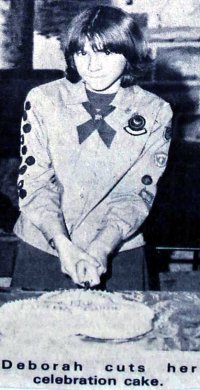
|
Brownies also started on the
27th October 1971 and Mrs Harriman ran the unit.
They met on a Monday night and had a full unit.
However after a number of years there were no
girls of 7 years of age so the unit closed and
the remaining Brownies joined Potter Heigham
Brownies and to this day any girls leaving
Rainbows go straight to Potter Heigham.
|
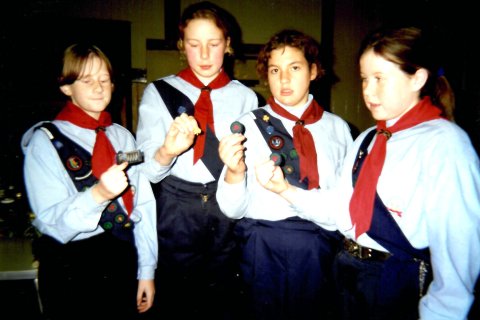
|
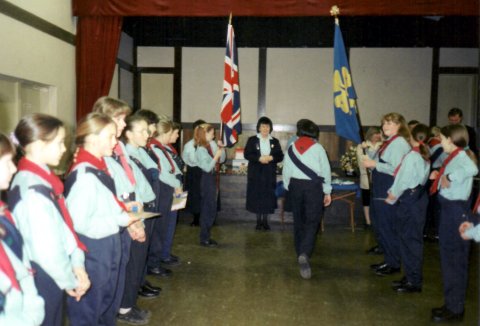
|
Rainbows opened on 3rd March
1998. Mrs J Dunnett is the Guider with Mrs J Jox
as assistant Guider. These young ones meet in
the Church Room on a Wednesday night. At the
start there were 15 Rainbows but as with Guides
and Brownies the numbers have gone down. It
seems there are no girls of Rainbow age in the
village.” |
Problems With The Boys Club
On May 8th 1981 there was an unusual event staged
by the boys of the village, it was a plea to 'Save
Our Club'.
Placard bearing members of Ludham Boys Club staged
a silent demonstration outside the Church hall. As
councillors arrived for the annual parish meeting,
they were met by the protesting banner waving
party of boys.
The boys were demonstrating against the decision
of Ludham First School head mistress, Mrs G.
Carter to refuse the Boys Club permission to meet
at the school on Friday nights. The banners they
held carried a blunt message to the councillors;
"Carter killed our club - will you bury it?"
Inside the meeting one of the Boys Club leaders,
Mr David Syrett said that the club had been unable
to meet for 6 weeks since being told that they
could no longer meet at the school on Friday
nights. Also, the alternate night they had been
offered, Thursday, was impossible because the 45
six to twelve year olds went to bed too late to be
ready for school the next day.
Those hundred or so people who packed the hall
voted overwhelmingly in favour of a motion put by
Mr Syrett that the parish council should support
the view and make representations to the education
authority that village schools be community
schools and used to their full potential.
The problem seemed to be that the Education
Committee would not authorise the payment of
cleaners after the Boys Club had finished on a
Friday night. |
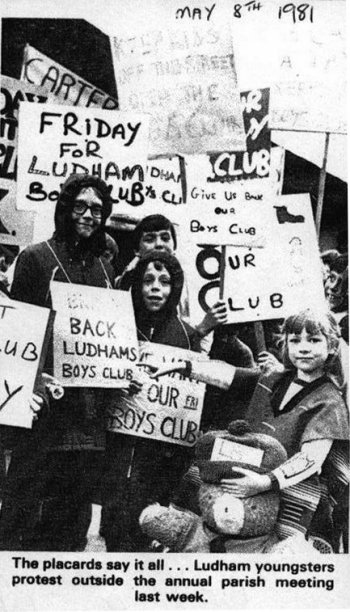
|
The Womack Herons
The Womack Herons is a club for people who enjoy boating
and meeting socially, and give each other help and advice.
The group was formed in the 1980’s by Wolf and Rita
Bubenza, and Alan and Sheila Gregory. They put notes on
boats on the staithe to see if anybody was interested in
going to an inaugural meeting at the Cringles Country Club
in Potter Heigham. About 30 people turned up and the
Womack Herons Club was born. The name was agreed upon, and
designs for a logo were also put forward and decided on.
<Picture> herons 2
The Womack Herons meet once or twice a month throughout
the year. Regular events include the Launching Supper when
they celebrate the end of winter and the return of the
boats to the water, and the Laying Up Supper when their
boats are put to bed for the winter.
Herons is a social club and as well as boating events they
have lots of other activities and outings. In the summer
they organise regular cruises to different Broads
locations. This might be for a barbecue, or a pub lunch or
picnic, or even a game of rounders. All the meetings are
informal fun events, and sometimes there is a quiz, or a
treasure hunt or photographic competition. Annual
membership is a small number of £’s per year and contact
details can always be found in the Parish News.
A personal account written by Wolf Bubenza can be found
at the end of this section.
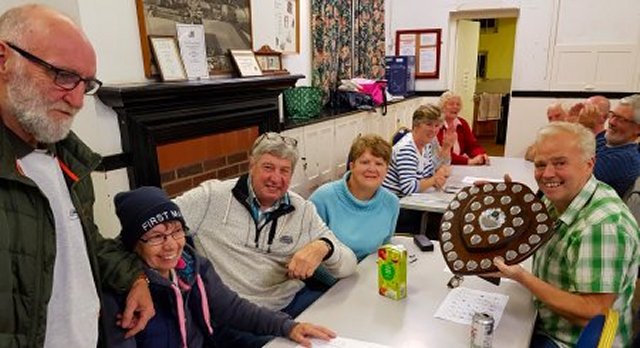
Every autumn, the Herons compete for the coveted Stan
Coles Trophy. It might be a quiz, a treasure hunt or some
other activity. There is always a twist to the competition
and it has provided lots of entertainment over the years.
Anyone who is interested in social boating on the Norfolk
Broads is welcome to join, you don't need to own a boat to
be a member.
Many of the meetings take place at riverside locations and
some people travel there by boat while others go by car.
There are always opportunities to get a lift on one of the
boats going to a meeting.
|
The Memories of Wolf
Bubenza:
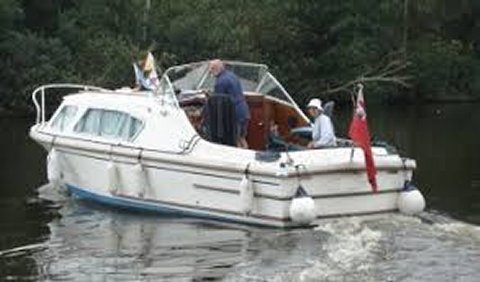
|
Having eventually got a Parish
Mooring, I saw all those boats tied up on the
Parish Moorings but no one spoke to anybody
along there, they passed each other but never
said hello or anything. I thought well, this is
silly. If people were going on your boat and
fishing off the front of your boat they would
make a mess by leaving bread and ground bait and
maggots crawling everywhere, so I turned a
couple of them off.
I thought to myself I had to do something
about this so I spoke to Alan Gregory, he had
his boat next to mine. I said to him what if we
form a club down here. He said “Good idea” and
volunteered to become the Vice Chairman and his
wife volunteered to become secretary and a
meeting was going to be held at Potter Heigham
(Cringles). Anyway, so they were the first 2,
then there was Tommy Knox and his wife, his boat
was 2 boats further down, I had a chat with him
as well and it wasn’t long before all 15 boats
in the north and south dyke all joined up and
became members of Womack Herons.
|
| We designed a little flag, a
blue one which they still have today I believe,
and we also put planking down on the ground
behind the boats so when we walked down to the
boats we didn’t pick up all the cut grass or the
mud when we went on our boats. We laid planking
all the way down to the South Dyke. We were
negotiating with the council to put a water tap
down there or even put a water tap on every boat
but they wouldn’t wear that, it was too
complicated. By this time we used to do outings.
The principle idea was that if someone went out
and broke down he could phone in and one of us
with a bigger boat would go out and tow him in. |
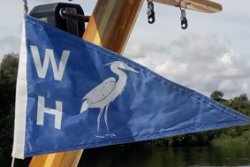
|
Ludham Ladies Handicraft Guild
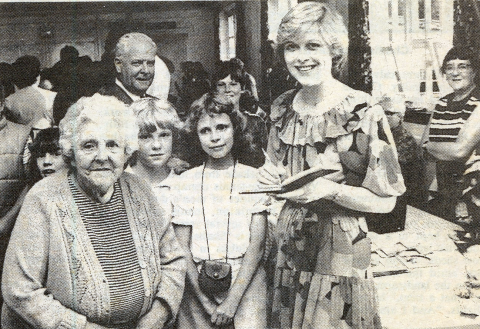
|
Autograph hunters meet Anglia
Television personality Christine Webber at a
summer sale organised by Ludham Lades’Handicraft
Guild.
The event raised £600 for the Guide Dogs for the
Blind Association and the Lockwood Donkey Santuary
at Wormley in Surrey.
|
|
The
Workers’ Education
Association (W.E.A.)
|

|
The Ludham Branch of the Workers’ Educational Association
(W.E.A.) was founded in 1903. It is a charity
dedicated to bringing high-quality, professional
education into the heart of a community. With the
support of nearly 3,000 volunteers, 2,000 tutors and over
10,000 members, they deliver friendly, accessible and
enjoyable courses for adults from all walks of life.
The WEA also has a special mission to raise aspirations
and develop educational opportunities for the most
disadvantaged. This includes providing basic maths,
English and IT skills for employment; courses to improve
health and wellbeing; creative programmes to broaden
horizons and community engagement activities that
encourage active citizenship.
Ludham Branch: Worker’s Educational Association -
1964/5 report by Phyllis Goodey
The local branch of the W.E.A. was transferred from Potter
Heigham in 1960.
The group meets in the school weekly during the winter
terms, with a coffee evening reunion before the beginning
of the winter season. A pleasant interlude occurs during
each meeting when coffee, made by Mrs Bird, is served with
biscuits. This usually provides an opportunity to begin
the very useful informal discussion which is an important
part of every lecture.
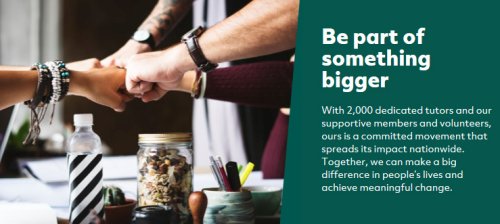
|
A wide variety of topics have been
studied, from Archeology to Mass media, from Music
to Biology. During the winter of 1964/65 the first
subject was the ‘Background to the New Testament’
with Miss Thicknesse, who knew her subject well,
and made the Bible characters and the ordinary man
really come alive and encouraged us all to do some
quite deep reading around the subject. Then
followed a second course on Art with Mr. Hamilton
Wood. An interesting evening occurred when twenty
members visited Norwich Castle Museum to study the
paintings exhibited in the Contemporary Art
Exhibition under Mr Hamilton Wood’s guidance.
However some members did not feel they could
appreciate fully some of the paintings, although
all felt that they had been helped considerably
towards some understanding of Modern Art. |
During 1964/65 the membership was 31 and among us were an
artist, a farmer, a doctor, a solicitor some teachers and
even some students.
The group is hoping for courses on Anthropology and
Norfolk Natural History during the season of 1965/66 and
members are keen to resume attendance at these most
enjoyable and instructive evenings.
Phyllis Goodey
A comprehensive survey of Ludham village was compiled by
the Ludham Branch of the W.E.A. group in 1980 following a
course on Industrial archeology.
The group members were:
L. Carter
M.
Hayes
D.
Sayer
J.
Clarke
S. Hayton
J. Sayer
C.
England
M. Keeler
M.
Walton
P. Goodey
N. Legg
B.
Winwood
B.
Gowing
J. Mchennan
J. Young
D. Hayes
O.
Mason
P. Young
The full survey can be found on the Ludham Community
Archive Website. To see the report follow this link
The Ludham Society
Taken from the Ludham Village Directory 1984:

The Ludham Society came into being in 1978 at a time when
there was dispute over the right of way at How Hill for
public access to the staithe.
The Ludham Society held a picnic on the staithe to support
the right of way issue and worked with the parish council
and the Ramblers Association to fight for it to stay open.
The society with Martin Walton as chairman, evolved into a
society for the protection of rights of way and amenities
in Ludham. They helped protect hedgerows and roadside
verges as well as actively taking part in tree planting
schemes for the village. They also kept a eye on buildings
within the village, especially those that were listed or
had specific covenants. The group was affiliated to the
CPRE and the Ramblers Association. They held monthly
footpath and bridleway walks covering all the paths around
the village in order to keep them open. They had a tree
nursery in the Manor grounds which helped them provide and
plant about 200 trees in and around Ludham until the task
was eventually taken over by the County Council. They were
responsible for the introduction of the school wild garden
so that the children would develop an awareness of nature
in a safe environment.
Gradually the society introduced talks on the countryside,
planning, architecture and local history so that the
members were well informed. There had been issues with
local farmers and the start of an annual farm walk was a
way to understand the working life of the farm and farming
legislation.
As a village, we owe much to the members of Ludham
Society, for they gave us our tree lined roads and kept
many footpaths open for us to enjoy.
The Playgroup and The Mother and Toddler Group
Again, taken from the Ludham Village Directory in 1984,
there were facilities for the young in the village as can
be seen from these cuttings.
ROYAL BRITISH LEGION - LUDHAM BRANCH
It is known that the Ludham Branch of the British Legion
was formed in 1944-5 from the local Catfield and District
Branch.
The joining fee in, 1944, was 1/- (5p) rising to
3/-(15p) per year. The numbers for 1944-5 were 45 members
and it increased to 102 by 1946-7, after men had returned
from the war; later it rose to the all time high of 124 on
the register and stayed that way until around the late
1970’s when it started to fall to 35-40 members at the
turn of the century.
The Ludham Branch also ran the house to house Poppy Appeal
until there were no members to do the collections. The
complete grounds of How Hill would be open at least one
Sunday per year when the entrance fee would be donated to
Ludham branch funds.
Later there were also xmas parcels delivered to the older
members or their dependants. Nowadays every penny has to
be agreed by head office before spending. By June 2006
there were not enough members to run it so it was closed.
The Cricket Team
A Pre War Team
Football In The Village
There were many football teams and leagues in the area
through the century, but there is relatively little
reference information to pass on to the reader.
An early team, the names and the date
are uncertain
Winners in 1937 - 38
Billy Wright played football for many years in Ludham,
mostly as centre half.
When asked if they had any successes he declared:
“We won the Norwich and District League, the North East
Village League, the Pierce Cup, and the Broadland Cup.
I’ve still got all the cups and medals that go with it.
I also ran the tennis club, and played tennis and
badminton. I played cricket for a couple of years but
unfortunately, the cricket folded and was never taken on
again.”
Winners in 1947 - 48
John Youngs played for a Ludham football team
“We were, at that time I think, playing in various
leagues in the Norwich and District football, also we
played in the first division Norwich and we played
Gothics Norwich Defiance. We played in quite a good
league then. Joyce’s dad used to run the line and
we used to pick the team in The Baker’s Arms. We
did that for several years.
Old Harry Warren used to go down the cellar and
get us a pint ‘out of time’. There were Ron Belson,
Billy Chapman’ Gordon Barber, Billy (Slug) Bensley, Ray
Osbourne, Michael Goodwin and myself . We were a good
football team and everyone played for a place in the
team. I was captain for several years but you were never
sure of your place, you had to earn it.”
Winners in 1959 - 60
The Bowls Clubs
Bowls clubs have been in Ludham village in some form or
other since the early 1800’s.
The King’s Arms auction bill mentioned the established
bowling green in the public house sale dated 1831, and was
in much demand. A second green was laid just before the
second world war but it was not used enough to cover the
expenses. Lockers were provided in an open front pavilion,
canes for measurement and a rotary pump for watering.
A Pre-War Team
Entrance to the Bowling Green at the
Kings Arms
War took many enthusiasts from the village and chickens
and rabbits occupied the well kept greens. There were many
other greens in the area, mostly belonging to private
houses. Latchmoor was a square area taken from the field
belonging to farmer Charles Green of Beech Farm and mostly
fellow tradesmen used that green. Beulah Gowing delivered
beer to their pavilion and to other venues when she was
14.
The bowling green at the village hall was laid much later.
Ladies bowls teams formed at the village hall after the
war.
Bowls Team at the Manor early in the
1930’s
Shown here (amongst others) in the back row are Mun
Grapes, Ted Gibbs, Bob Allard, Fred Thrower, Jack
Wright, Albert Warner, G. Pollard, Sydney Amies, Whiskey
Wright, Arthur Grapes, Johnny and Freddie Thrower, Vivien
Rudrum, Fred Skillern, Billy Barber and Tom Lacey.
In the front row we see George Lincoln, Herbert Alcock,
Kenny Grapes, Harry Dean, Tom Kitchener, Jack Fuler, Jimmy
Beevor, George Hayhurst, Col. Worship or Capt. Armytage,
and Loney England.
A much later bowls team, showing Steven Bensley, David
Mattocks, Laurie Marshall, Marion Gibbs, Howard Wade,
Neville Boldy, Rodney Wright with shield, Richard Vepson,
Richard Locke, Sonny Probertt, Arthur Browne and Brian
Saunders.
Arthur Browne moved to Ludham in 1978, having lived in
Sutton before that. He met with Arthur Gower the butcher,
and got invited to the Bowles Club. Arthur Gower had said:
Just bring a pair of plimsolls and I will sort you out.
“I had Fred Pettitts bowls (Nurse Pettitts father).
They were a proper old set of wooden ones. Older bowls
were made from Lignum Vitae and very heavy. I had a go.
He then told me to look on the butcher’s door and I
might be on the team, although I’d only had that one go.
And I’ve played there with Jack Fuller, Mike Fuller’s
dad ever since and I’ve really loved it.
There were several bowling green’s within the
village at one time. There was a green off Latchmoor,
down by the bungalow just past the junction. There was
also a green at the back of the Kings Arms. It was much
earlier but it was still there when I moved to the pub
to cut the grass for Tom Billington. The pub bowling
green was where the restaurant is now. It had not been
used for a while and when it was measured up, it was
long enough in one direction, but not the other.
The green at the village hall was originally
the Ladies Green. The ladies played at the village hall
whilst the men played at Latchmoor and the Kings Arms.
The Kings Arms was shut first, and then Latchmoor, and
then everyone played at the village hall. It was not an
easy transition when we all shared the village hall
bowling green. The men paid to have the village hall one
expanded, and Richard Locke built the new pavilion but
the ladies were not too pleased to be sharing, at least
that’s how it appeared at the time.
As from October 1986, the Ladies and Mens Bowls
Clubs were amalgamated forming The Ludham Bowls Club. At
the formation of this club it was agreed to re turf the
green and various activities such as Whist Drives and an
Old Time Music Hall were put on in the village hall to
help raise the money we needed.
The club plays various fixtures such as the Taylor
Shield and The Rotary Shield, and have at times played
for the Yarmouth League Cups. In April 1992 they had
about 58 fixtures for the coming season and membership
ran to about 31 members.”
|
Irene Haslem with cup
presented by Alex Cordiner
|
Arthur winning the singles trophy and kissing
it
|
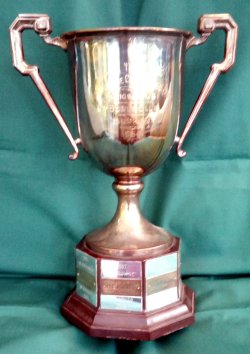
|
The Armytage Challenge Cup was presented to the
Club by Mrs Armytage who lived at the Manor. She
later became Mrs Brook. There are many names on
the cup of winners from the past.
At one stage the cup disappeared but after twenty
years it was found in someone’s loft and once
again was used as a challenge cup.
The inscription on the cup reads:
The Armytage Challenge Cup
Kings Arms
Bowls Club
Ludham
1934
|
Past winners are:
1934 H E Miller
1935 W W Gibbs
1936 F
Skillern
1937 W A Kemp
1938 S Amis
1949 F Skillern
1950 Kenny
Grapes 1951
Kenny Grapes 1952 Kenny Grapes
1997 A Browne
1998 R Sparrow
1999 M
Cooper
2000 D Mattocks
At the time of writing, the cup also shows the following
names:
2001 I Walter
2002 T
Grapes
2003 I Walter
2004 W Ribbands
2005 M Barker
2006 M
Barker
2007 W Brinded
2008 S Probett
2009 S Probett
2010 S
Probett
2011 S Wright
2012 M Gibbs
2013 Jill
Grapes 2014 S
Probett
2015 A
Browne
2016 D Mattocks
2017 D Mattocks
The Darts Team
The regular darts players at The Kings Arms were Jimmy
Cook, Pat Algar, Tony Hurn, Beenie Vout, Harry
Warren, Martin Beaumont, Beenies son Danny, Richard
Locke, Micky Harvey, Arthur Browne, Jerry Young, landlord
Peter Billington, Tony Burton, John Shelby, all Ludham
people in 1983.
In 1984 they won the League and were League Cup Holders.
For many years they were either winners or runners up, and
never came away without a cup. They were in the North
Walsham and District League, then in the Wherry League;
Garry Timmons being the captain. The only night they had
off was Friday night. Rodney Wright ran the Wednesday
Night league, and Arthur Browne ran the Monday and
Thursday Night local leagues.
King's Arms Darts players after their
40 hour £1000 fundraising marathon.
Back Row: Danny Vout, Pat Algar, Pete Billington,
Gerry Hunn.
Front Row: Arthur Browne, Richard Locke, Paul Warren,
Garry Timmins.
Darts team wives raise money for the
Jenny Lind Ward at The Norfolk and Norwich Hospital
Enid Carter, Tanya Lavender, Elaine lavender, Kathy Hunn
Robert Hunn, Raymond Hunn, Christine Cook, Sam Billington,
Sarah Billington
Ludham King's Arms won the North Norfolk Darts League
Inland section and The Knockout Cup - the first time the
Double had ever been achieved.
Back row: Arthur Browne, Gerry
Hunn, Peter Billington,
A. Burton, J. Shelvie, Tony Hearn, Pat
Algar, J. Cook.
Front row: Mickey Harvey, Richard Locke, Danny
Vout,
Martin Beaumont, Paul Warren, W. Vout.
Snooker
This photo was found under the snooker table in the
village hall. It relates to a Snooker 24 hour
marathon, as a result of which, £250 was raised and
donated to the For Get Me Not Club.
In the photo we see Mr Bigg, Derek
Smith, Michael Harvey and Mrs Alexandra
When interviewed some years ago, John Youngs said:
“We are very lucky – the snooker room is used by all
the elderly people – they go in there during the
day. They enjoy their game of snooker – in fact,
there are as many as seven or eight cars out there
during the day. They can boil their kettle and
have a cup of tea”
|
|
|



